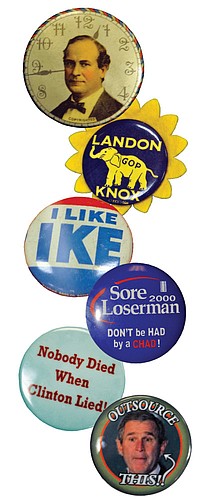- April 25, 2024
-
-
Loading

Loading

It’s that time of year again when our televisions become flooded with commercials, our phones with ring with endorsement calls, our yards are staked with red or blue signs and our dinner tables are filled with political conversation. But the South Florida Museum has less of a daunting take on the upcoming elections.
Tuesday, Aug. 28, just in time for the Republican National Convention (Aug. 27 to Aug. 30), The South Florida Museum, in Bradenton, will unveil a new exhibit. “Vote for Me! Vote for Me!” will feature the history of presidential elections through objects used to market past campaigns.
More than 1,000 pieces of paraphernalia, including buttons, lapel pins, tobacco pipes, hats, posters and more, dating back to the first presidential election of 1789 up to modern-day elections, will be exhibited in the Curator’s Choice Gallery.
These objects suggest the changing face of political campaigns over time. It’s fascinating to see items dating back to Washington’s unopposed elections juxtaposed with today’s competitive campaign swag. President Washington was revered, and political objects weren’t intended to gain votes. Today’s election bumper stickers suggest a bit more contention.
But nasty races are nothing new. The races between Democratic-Republican Thomas Jefferson and Federalist John Adams, in 1800 and 1804, suggest that the intense competition between candidates witnessed today dates pretty far back.
It was the 1840 election between Harrison and Van Buren that influenced campaign marketing via slogans, songbooks and banners. Then there’s also the late ’60s and early ’70s, when button collectors created a market for campaign buttons.
The exhibit will also feature a broader scope than just political pieces. There will be exhibits about historical pieces of technology, such as the telegraph recording machine, and how it was used to get the results of the vote out along with educational material that gives the history of elections and candidates.
All political parties, history-buffs and even those who struggle naming all the presidents, will find something in this exhibit. It is a great civics lesson as we travel head-on into the next campaign.
IF YOU GO
‘Vote for Me! Vote for Me!’
When: 10 a.m. to 5 p.m. Tuesday to Saturday; noon to 5 p.m. Sundays; closed Mondays. Exhibit runs from Aug. 28 to Nov. 25.
Where: South Florida Museum, 201 10th St. W., Bradenton
Cost: Adults $15.95, seniors $13.95; children $11.95
More info: Call 746-4131 or visit SouthFloridaMuseum.org
 1860 — This small flag would have been displayed in storefronts or windows of homes, and it’s safe to say these were seen in the Northern states.
1860 — This small flag would have been displayed in storefronts or windows of homes, and it’s safe to say these were seen in the Northern states.
 1884 -– Starting in the mid 1800s, during the days leading up to elections, torchlight parades were used to rally voters. Men would march with torches, which endorsed particular nominees.
1884 -– Starting in the mid 1800s, during the days leading up to elections, torchlight parades were used to rally voters. Men would march with torches, which endorsed particular nominees.
 This is a drapery tieback dating to the first election. Instead of campaigning (Washington ran unopposed), these showed revere for the president.
This is a drapery tieback dating to the first election. Instead of campaigning (Washington ran unopposed), these showed revere for the president.
 The Chicago Tribune’s 1948 headline falsely read “Dewey Defeats Truman.” The paper had to go to press before the East Coast could determine results, but the paper’s prediction of the election was false, and it erroneously reported the results.
The Chicago Tribune’s 1948 headline falsely read “Dewey Defeats Truman.” The paper had to go to press before the East Coast could determine results, but the paper’s prediction of the election was false, and it erroneously reported the results.